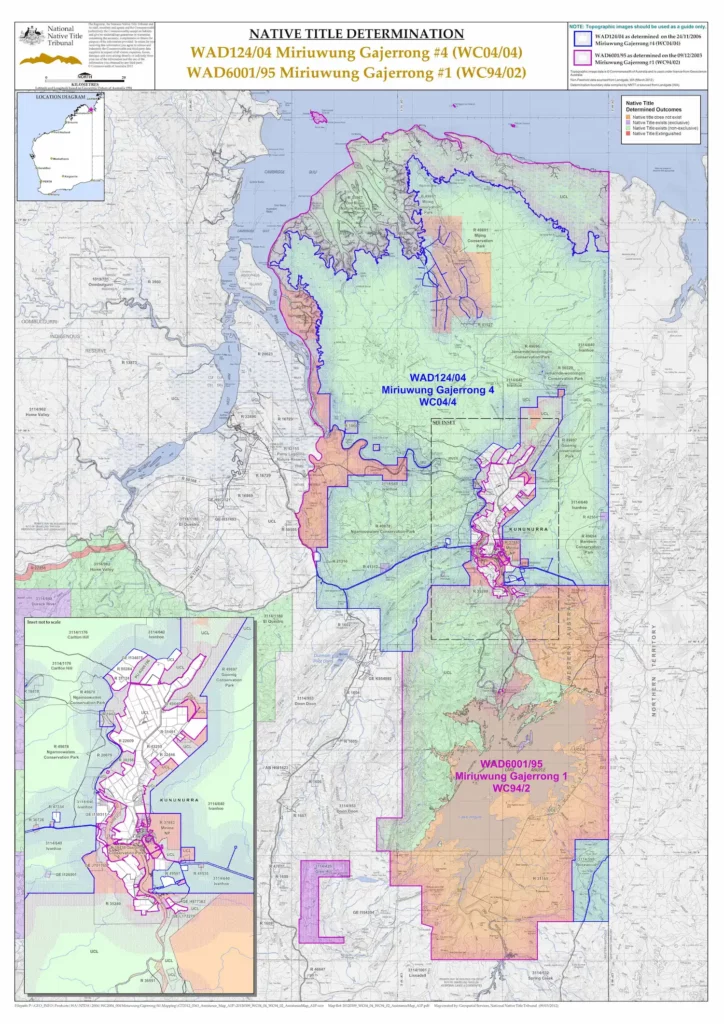Our Country
‘This is stony country—when I walk across this country where the creeks and the floodwaters have been there are lots of rocks and little stones. Lots of these stones are beautiful coloured ones. We call them gerany.’
The East Kimberley has a dazzling array of ecological variance within its bounds. The region’s north mangrove coastal flats and the mouths of river valleys, while further down there are grassy plains and savannah forests and woodlands, deep gorges cutting through sandstone and enormous limestone outcrops, with the southernmost area is home to semi-desert savannah.
The East Kimberley is a largely arid to semi-arid climate, prone to high temperatures and winter drought. The year is divided into a wet season running from December to April, a cool dry season in mid-April to early August and a warm dusty season from late August to early November, when rain can start to fall.
Native Title
During the 1990s MG people claimed Native Title over two adjacent areas of the East Kimberley bordering the Northern Territory. Following a decade of protracted litigation, in 2003 and 2006, the Australian courts officially recognised that MG people have Native Title rights over land in specific regions of the East Kimberley.
Native Title Judgments

Goomig Lot 15 & Goomig Lot 16
Goomig Lots 15 & 16 are located in the Ord River region near Kununurra comprising 665 hectares of land across two parcels in the Goomig farmlands. MG Corporation’s ownership of the land was part of a settlement under the Ord Final Agreement, which provides opportunities to undertake commercial irrigated agriculture operations on the land.
Since ownership was transferred to MG Corporation in 2020, the land has been used to successfully trial cotton crops, with an ongoing commercial cotton venture set to be established in the future.
MG Corporation has a water and environmental management infrastructure agreement with Kimberley Agricultural Investment, which farms the balance of the Goomig area.
Yardungarrl
Yardungarrl is located on the WA/NT border and is home to eight Aboriginal communities. In August 2007, the WA Government handed back 50,000 hectares of land, freehold, to the Miriuwung Gajerrong people. It was the largest handback to take place in WA.
Weaber Plains Reserve
Weaber Plains Reserve consists of 107 hectares across three parcels of land to the east of the Kununurra townsite, offering protection of sacred sites and direct employment opportunities for MG people. The land was approved for transfer to MG Corporation in early 2021.
Yoorrooyang Dawang Regional Park Council
The Yoorrooyang Dawang Regional Park Council represents a joint initiative between MG Corporation and the Department of Parks and Wildlife for the management of six new conservation areas that were created under the OFA, as well as three existing conservation areas in the Kununurra area.
The Council comprises representatives from the Department of Parks and Wildlife and MG representatives from each relevant Dawang group and makes decisions about the management of the conservation areas.
Ongoing works affecting the conservation areas include: signage in Miriuwung; installation of infrastructure to facilitate tourism in the region; ecological and cultural mapping; tourism development opportunities; implementing a weed strategy; wildfire mitigation plans; creation of trainee programs and supporting existing community relation programs.
The Yoorrooyang Dawang Regional Park Council is proud of its management team including three MG rangers, all of whom are encouraged to complete tertiary Conservation and Land Management qualifications.
Yoorrooyang Dawang Regional Parks Council Management
Ngamoowalem Conservation Area Representatives (Dawang):
- Joanie Simon (Wijilawarem)
- Susan Simon (Wijilawarem)
- Jacoba McKenzie – Proxy (Wijilawarem)
- Margaret Moore (Kalamunda)
- Jessica Webster (Kalamunda)
- Rexalea Webster – Proxy (Kalamunda)
Darram Conservation Area Representatives (Dawang):
- Helen Gerrard (Yirralalem)
- Carol Hapke (Yirralalem)
- Jason Reid – Proxy (Yirralalem)
- Jannelle Ningamarra (Balaburr)
- Lola Ningamarra (Balaburr)
- Jameson Calwatt – Proxy (Balaburr)
Barrbem Conservation Area Representatives (Dawang):
- Georgina Wilson (Wirram)
- Terry Wilson (Wirram)
Goomig Conservation Area Representatives (Dawang):
- Jonathon Boombi (Bigainybang)
- Jimmy Paddy (Bigainybang)
Darrmalanka Conservation Area Representatives (Dawang):
- Ralph Gerrard (Wadainybeng)
- Elizabeth Chunnary (Wadainybeng)
- Dianne Gerrard – Proxy (Wadainybeng)
Mijing Conservation Area Representatives (Dawang):
- Rozanne Bilminga (Wadainybeng)
- Julie Bilminga (Wadainybeng)
- Loretta Bilminga (Wadainybeng)
Yoorrooyang Dawang Regional Parks Rangers
Male MG Rangers:
- Wayne Winton
- Andy Reid
- Jeremy Moore
- Clay Peart
- David Newry Jnr
- Winston Gerrard
- William Simon
Female MG Rangers:
- Miriam Calwatt
- Edwina Bilminga
- Nina Webster
Reserve 31165
Reserve 31165 covers 125,000 hectares and is bordered on two sides by Lake Argyle. The reserve is jointly managed by MG Corporation and the Western Australian Department of Water.
A Joint Management Committee is responsible for creating, implementing and monitoring the Management Plan for the reserve. The Joint Management Committee comprises representatives from the Department of Water and from each of the four Dawang groups within Reserve 31165, namely: Bilibijing, Yunurr, No Name and Mandangala.
Ongoing works affecting Reserve 31165 include the monitoring of use of the land by pastoral lessees, weed management, fencing programs, fauna surveys, identifying tourism and development opportunities and ongoing community relations.
In addition to the collaboration between MG Corporation and the Department of Water, a Service Level Agreement has been entered into between MG Corporation and the Department of Parks and Wildlife for the operation of a ranger program at Reserve 31165. Funded by the Commonwealth Government through its ‘Working on Country’ program, the ranger program provides funding for four full-time rangers and a ranger supervisor to work on Reserve 31165. Each of the rangers represents one of the four Dawang groups within the reserve.
